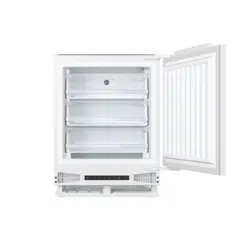Loading ...
Loading ...
Loading ...

9
The manufacturer declines all responsibility in the event of the
installer failing to observe all the accident prevention regulations in
force, which are necessary for normal use and the regular operation
of the electric system.
Electrical connection
YOUR FREEZER IS INTENDED FOR FITTED AND PERMANENT
INSTALLATION.
We recommend that the appliance is connected by a qualified
electrician, who is a member of the N.I.C.E.I.C. and who will comply
with the I.E.E. and local regulations.
o
Your freezer comes supplied with a 13 amp plug fitted. If in future
you need to change the fuse in this plug, then a 13 amp ASTA
approved (BS 1362) fuse must be used.
o
The wiring in the mains lead is coloured as follows:
Brown Live
Blue Neutral
Green and yellow Earth
o
As the colours of the wires in the appliance’s mains lead may not
correspond with the coloured markings identifying the terminals in
your spur box, please proceed as follows:
The brown wire must be connected to the terminal marked “L” (live),
or
coloured red.
The blue wire must be connected to the terminal marked “N”
(neutral), or
coloured black.
The green and yellow wire must be connected to the terminal
marked “E”
(earth), or by the earth symbol, or coloured green and yellow.
o
When the connection is completed, no stray strands or cut wire
should be present. The cord clamp must be secured over the outer
sheath.
Positioning
o
It is advisable that your appliance is only installed in a location
where the ambient temperature of the room, corresponds with the
climate classification that is stated on the rating plate of your
appliance. Your appliance may not function correctly if the ambient
temperature falls outside of the following ranges.
- Extended temperate (SN): ‘this refrigerating appliance is intended
to be used at ambient temperatures ranging from 10 °C to 32 °C’
- Temperate (N): ‘this refrigerating appliance is intended to be
used at ambient temperatures ranging from 16 °C to 32 °C’
- Subtropical (ST): ‘this refrigerating appliance is intended to be
used at ambient temperatures ranging from 16 °C to 38 °C’
- Tropical (T): ‘this refrigerating appliance is intended to be used at
ambient temperatures ranging from 16 °C to 43 °C’
o
Your appliance should not be located in direct sunlight or exposed
to continuous heat or extremes of temperature (e.g. next to a
radiator or boiler).
o
The door should be able to open completely and freely.
o
The appliance should be situated so you can easily access the food that is
stored in it.
o
You should check whether there is an electrical socket available, which will be
accessible after your appliance is installed.
Reversing the door of your appliance
This procedure MUST be completed before the furniture door is attached. Any
parts that you remove from the appliance whilst reversing the door, should be
retained for later use.
WARNING - Take care when opening the hinges, they are sprung loaded and
there is the risk of injury if they close on your hand.
Tools required:
o
Phillips screwdriver
o
Flat bladed screwdriver
o
Slacken the retaining screws (1) on the appliance and then carefully remove
the appliance door.
o
Place the appliance door on a cushioned surface, so that it does not get
damaged.
o
Lever off the cover caps (3).
o
Insert the retaining screws (1) into the opposite side of the appliance from
their original position. These screws should be partially tightened but not fully
tightened.
o
Remove the door retaining screws (2) and then reverse the position of the
top and bottom hinge (as shown in the above diagram).
o
Reattach the appliance door and then fully re-tighten the retaining screws
(1) and the door retaining screws (2).
o
Insert the cover caps (3) into the holes that are now exposed on the right
hand side of the cabinet.
IMPORTANT: Check that the door opens and shuts correctly, without fouling,
after you have completed the door reversal process.
After the door has been reversed, you should check the door seal of the
appliance. The seal should not be creased or crushed; otherwise there will be
a gap between it and the inside of the door.
o
The seal must adhere properly all the way around the door.
o
If the seal is not adhering to the cabinet properly, then you should either:
1.
Use a warm damp cloth and manipulate the seal until it does adhere to the
cabinet properly, all the way around the door.
Or
2.
Use a hair dryer on its lowest heat setting and lightly heat the areas of the
door seal that are not adhering correctly. The heat will make the seal more
pliable and this will allow you to manipulate the seal into the correct position.
IMPORTANT: DO NOT HEAT THE DOOR SEAL ON ANYTHING BUT THE LOWEST
HEAT SETTING, OR HEAT THE SEAL FOR A LONG PERIOD OF TIME. OTHERWISE
Loading ...
Loading ...
Loading ...
